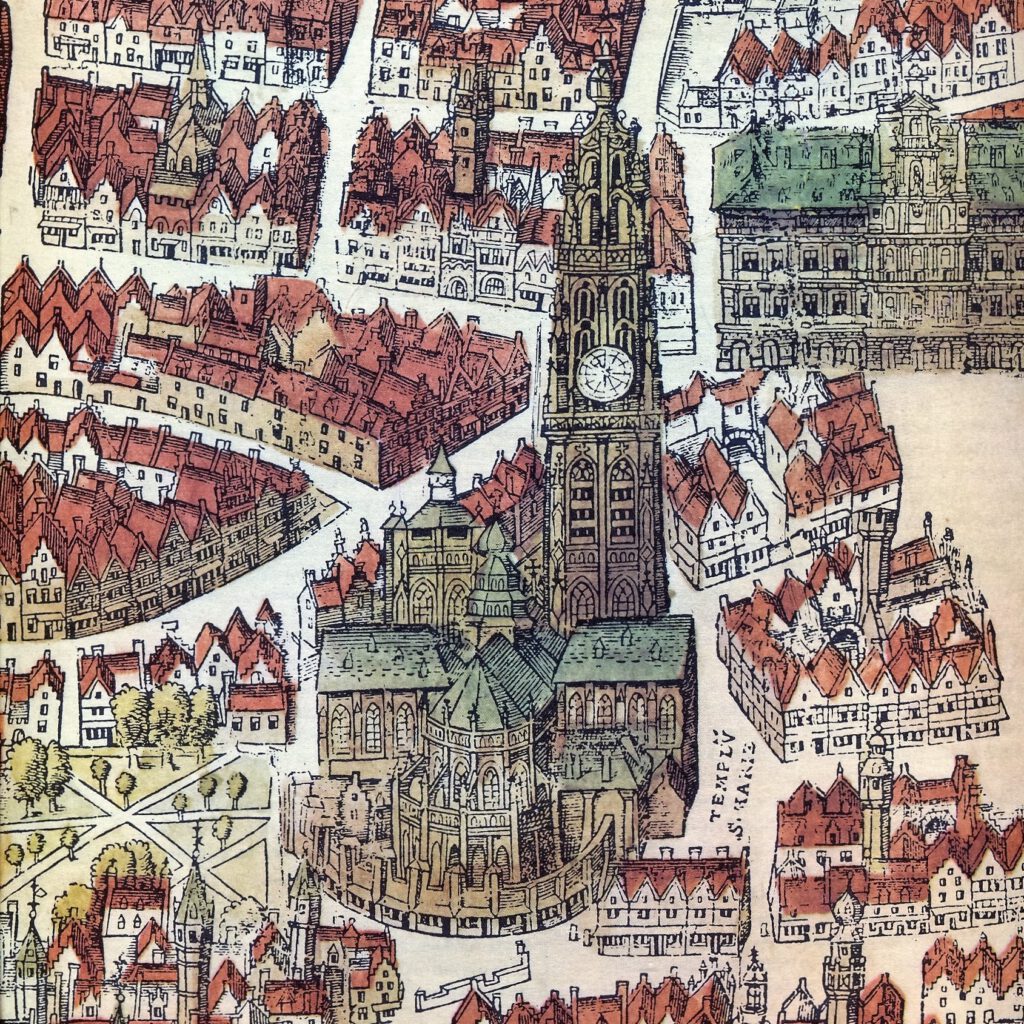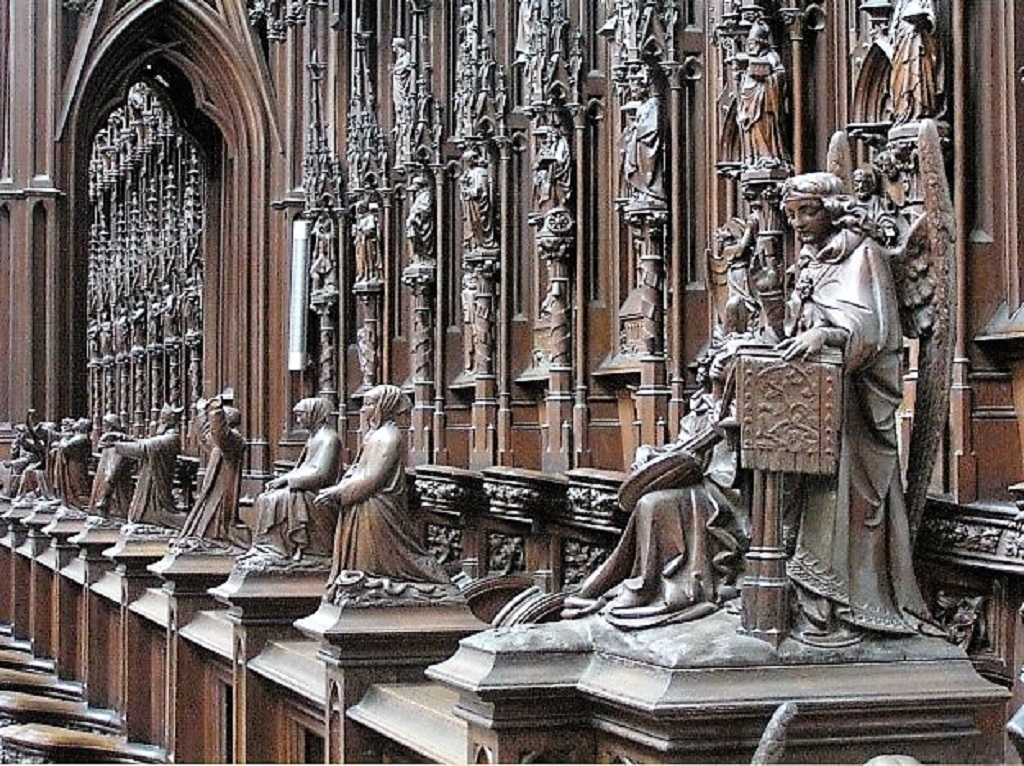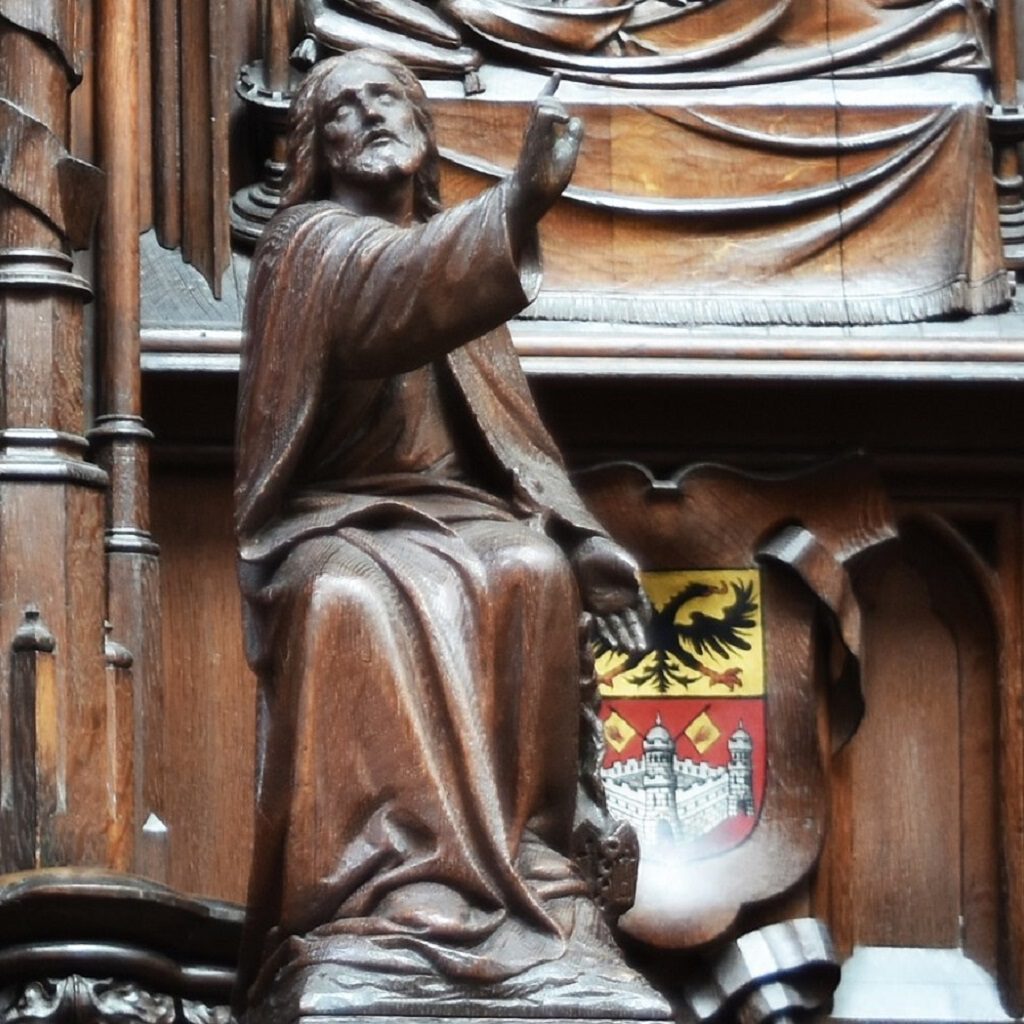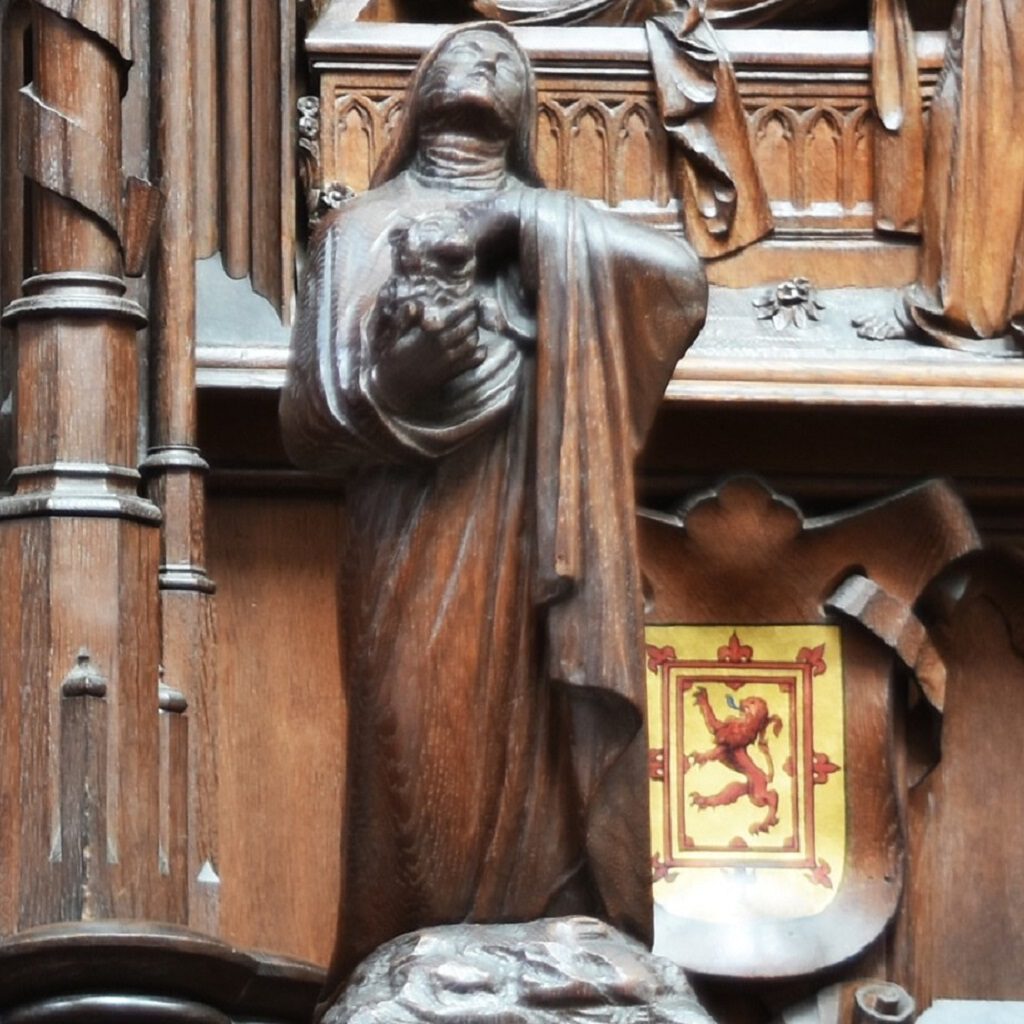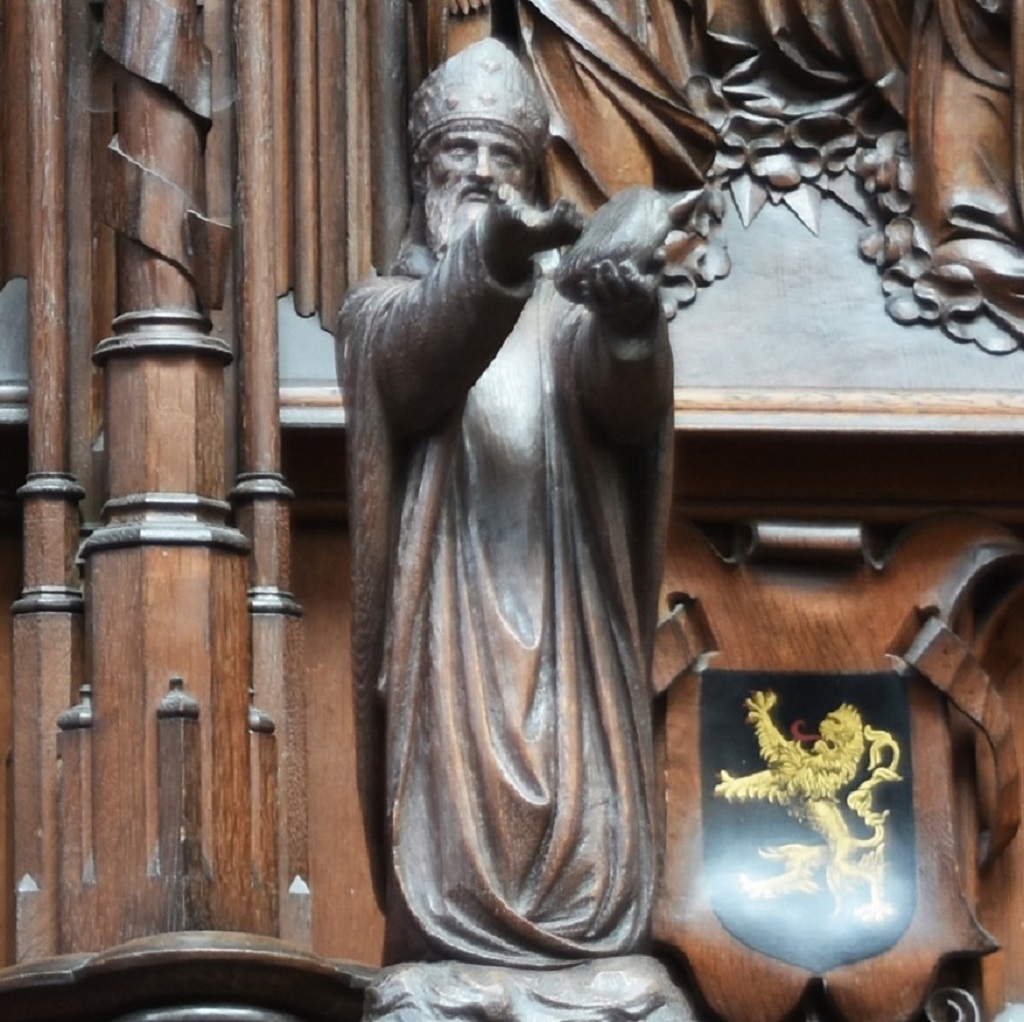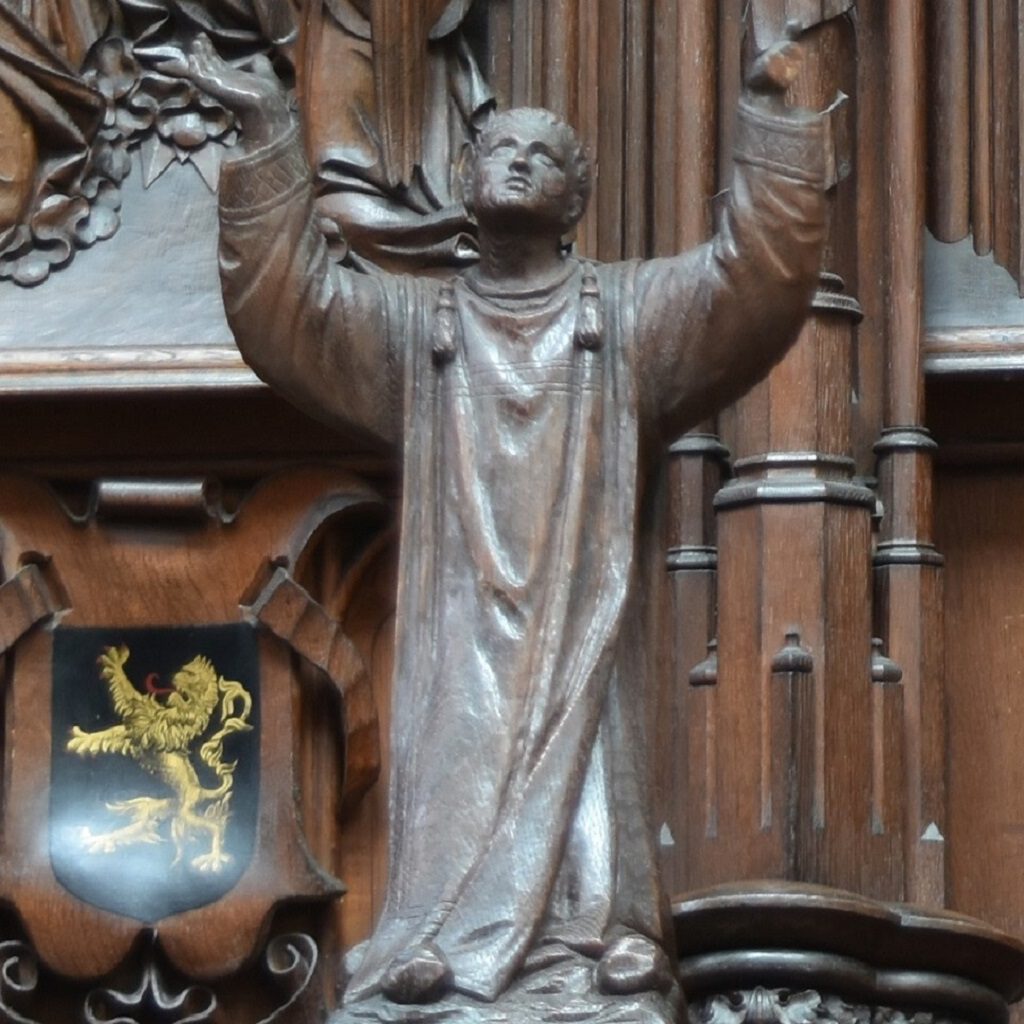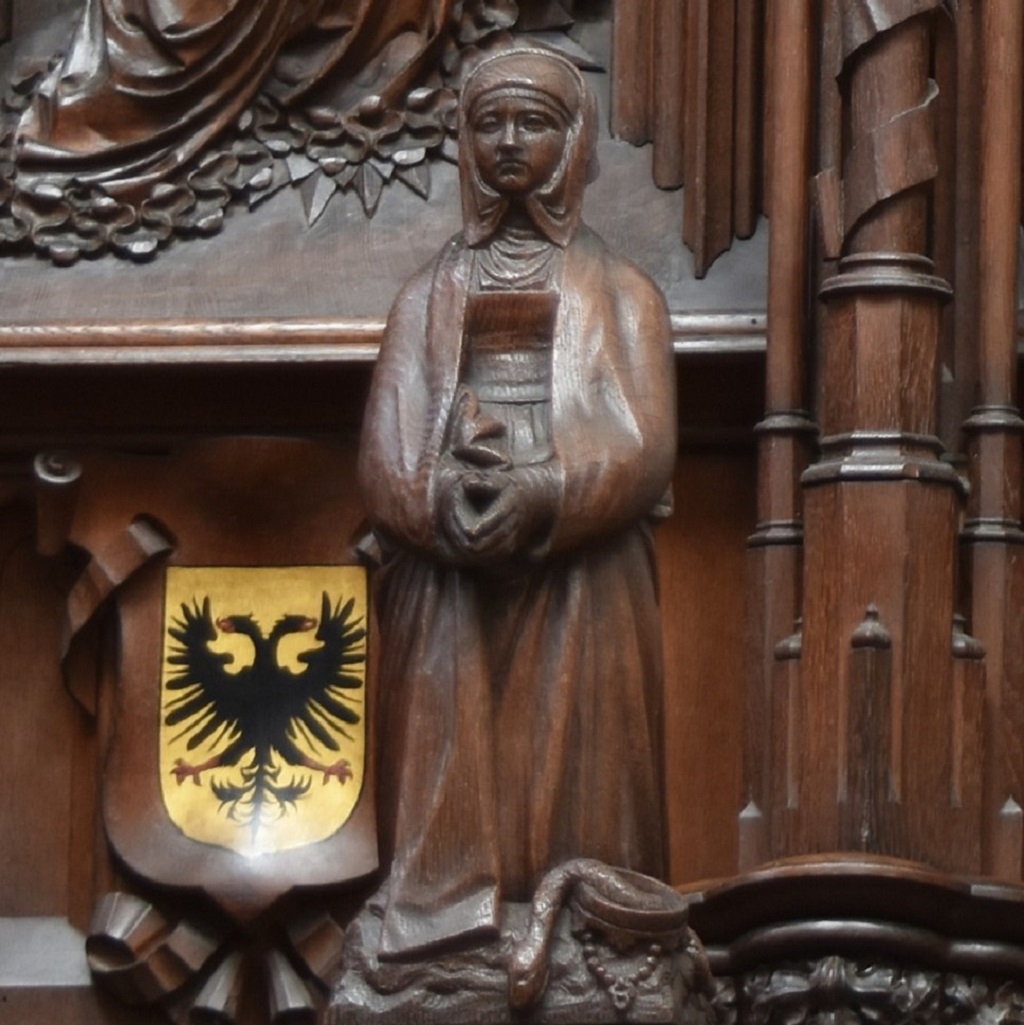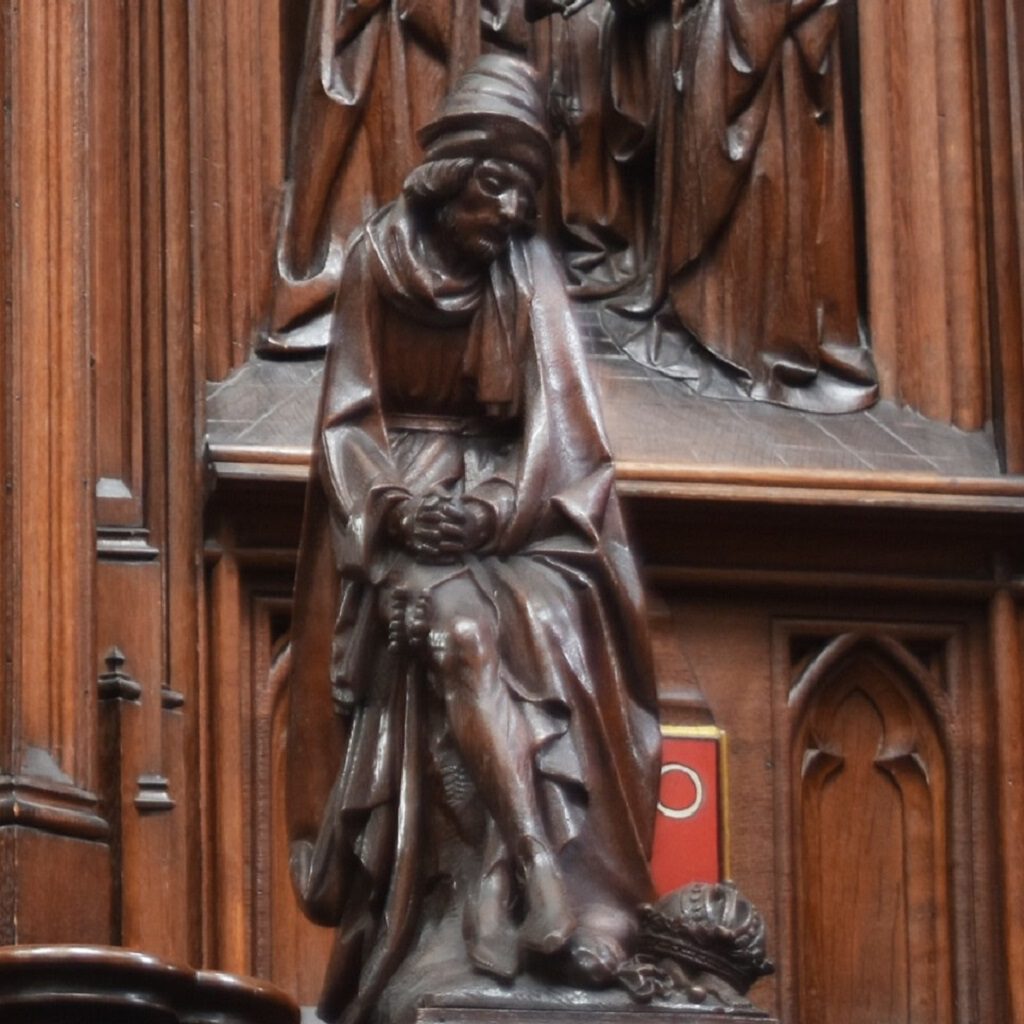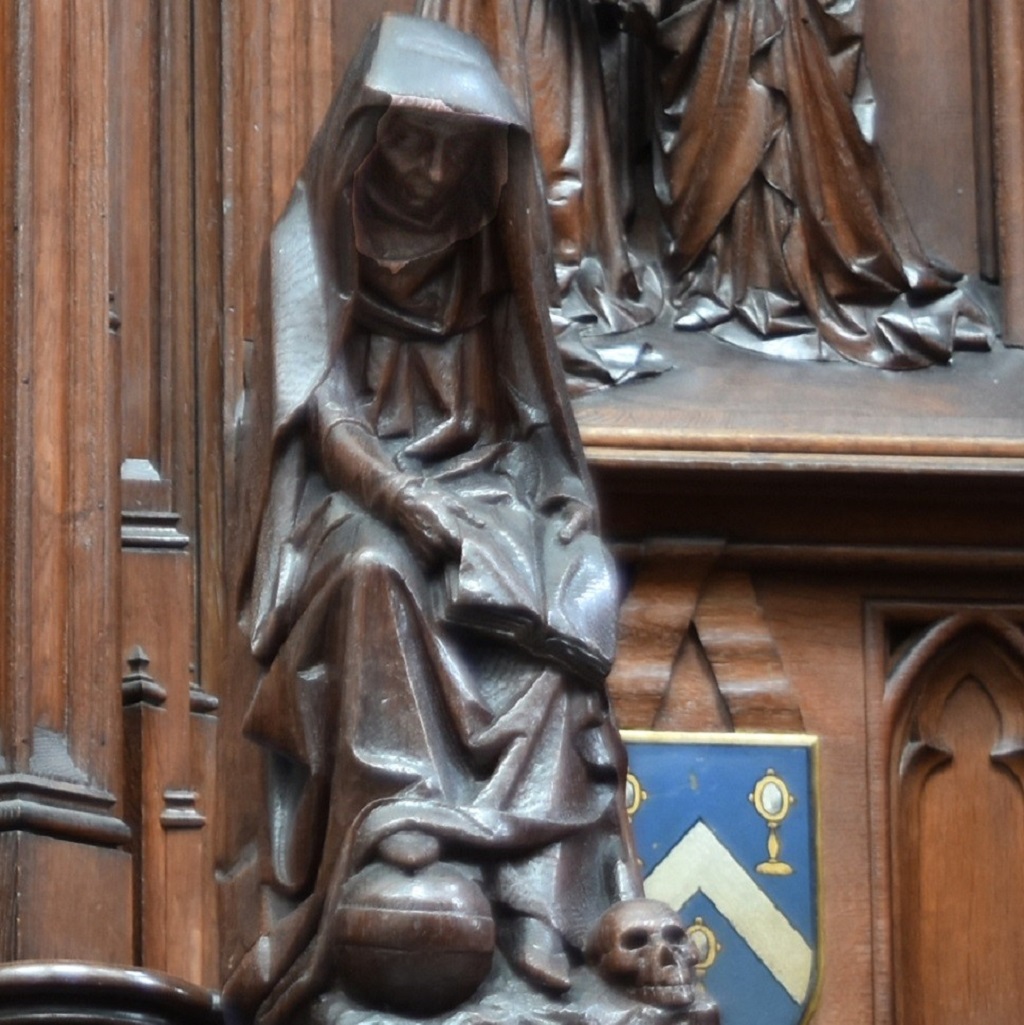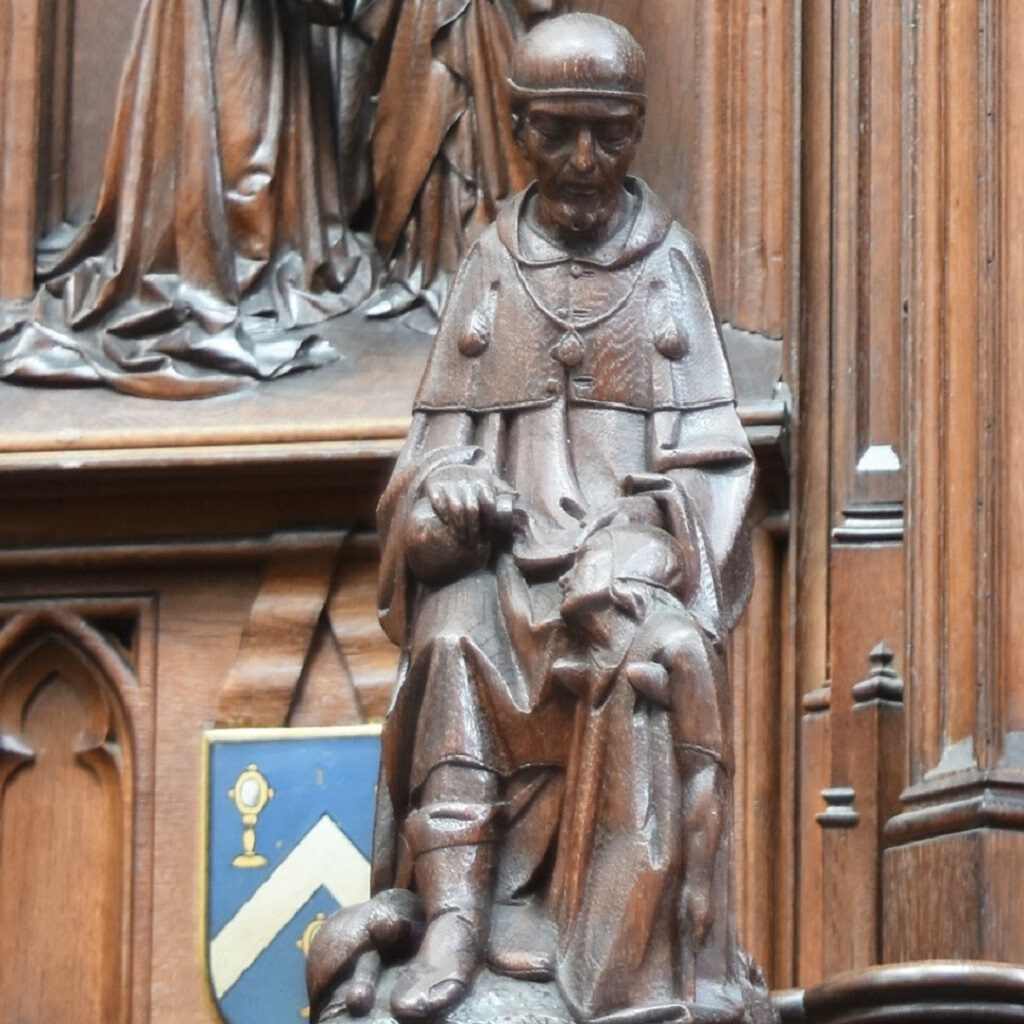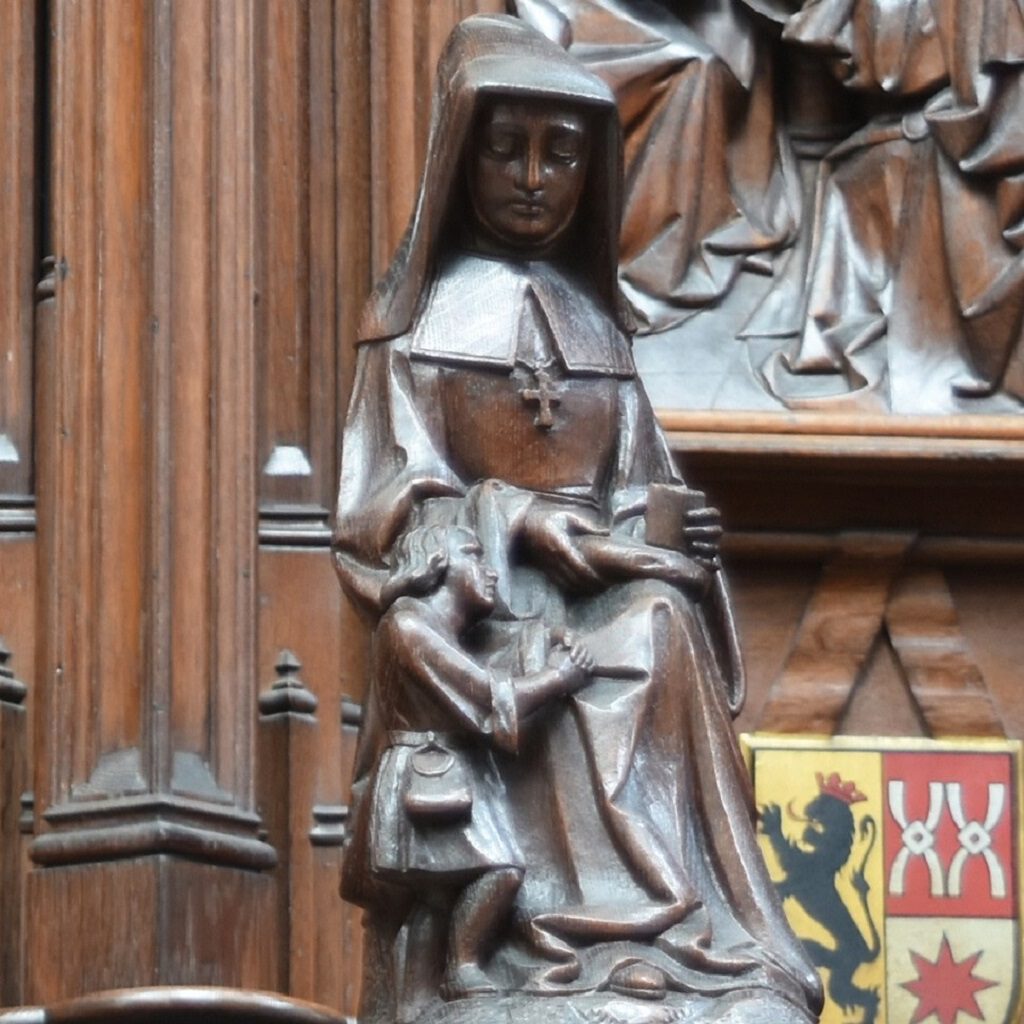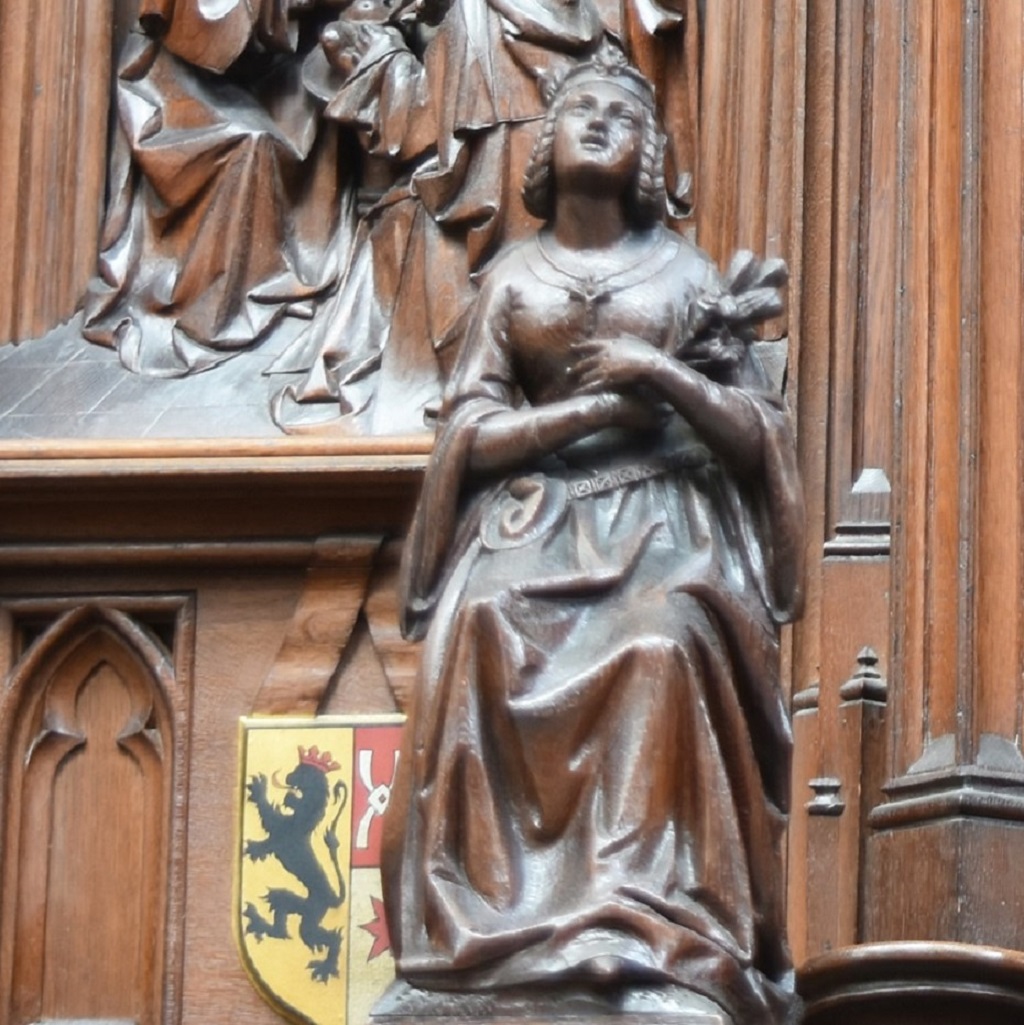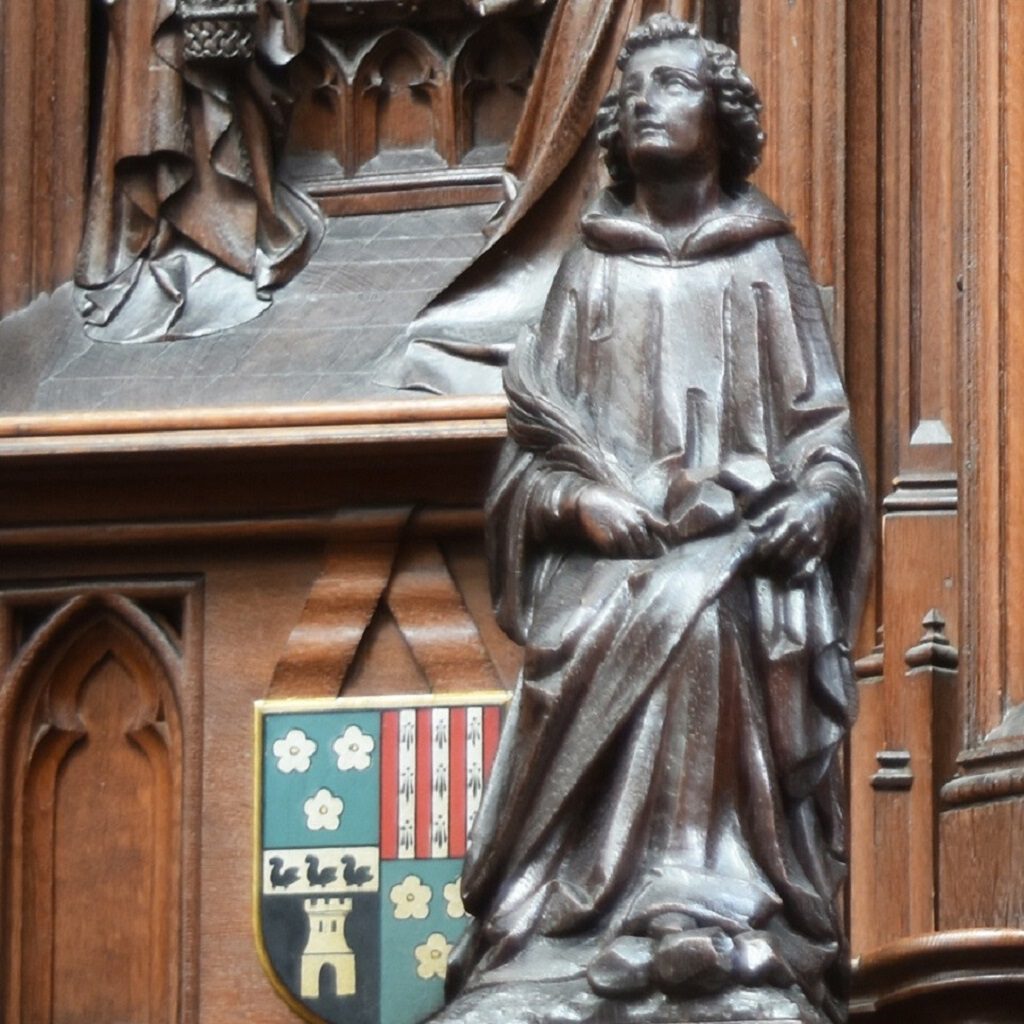The Our Lady’s Cathedral of Antwerp, a revelation.
The collegiate church with the choir
Between the moment the foundations were laid and the choirIn a church with a cruciform floor plan, the part of the church that lies on the side of the nave opposite to the transept. The main altar is in the choir. was vaulted some forty years elapsed: from 1351 till ca. 1391. Together with the truss the choir and its vaultings are among the oldest, nearly intact architectural realisations to be found in Antwerp. Most keystones date back to just before 1391. Since the 1992 restoration they have been showing their original qualities and their bright polychromy, which was preserved underneath several layers of whitewash. The first effigy we discern from West to East is John the Baptist, who points at the Lamb of God on his arm. The lost sculpture of the second keystone was renewed with a relief of Mother Mary and Child in 1993. Saint PeterHe was one of the twelve apostles. He was a fisherman who, together with his brother Andrew, was called by Jesus to follow Him. He is the disciple most often mentioned In the Gospels and the Acts of the Apostles. His original name was Simon. He got his nickname Peter (i.e. rock) from Jesus, who, according to tradition, said that He would build His Church on this rock. proudly shows his power over the keys and shows his article of faith in an open book: ‘Credo in Deum p[atrem]’ (I believe in God the FatherPriest who is a member of a religious order.). Finally everybody is blessedUsed of a person who has been beatified. Beatification precedes canonisation and means likewise that the Church recognises that this deceased person has lived a particularly righteous and faithful life. Like a saint, he/she may be venerated (not worshipped). Some beatified people are never canonised, usually because they have only a local significance. by Christ as Salvator Mundi in the apseSemi-circular or polygonal extension where the high altar is located in a church.. The fact that His face is broken has probably been caused by the metal tube that was later pierced through the embossing. Because this mysterious tube is at the culmination point of the six vaulting ribs it happens to be at the level of His mouth. It opens out to a brick tray above the vaulting. Was it used to hang up something above or in front of the Medieval or Baroque high altarThe altar is the central piece of furniture used in the Eucharist. Originally, an altar used to be a sacrificial table. This fits in with the theological view that Jesus sacrificed himself, through his death on the cross, to redeem mankind, as symbolically depicted in the painting “The Adoration of the Lamb” by the Van Eyck brothers. In modern times the altar is often described as “the table of the Lord”. Here the altar refers to the table at which Jesus and his disciples were seated at the institution of the Eucharist during the Last Supper. Just as Jesus and his disciples did then, the priest and the faithful gather around this table with bread and wine.? Or was something strewn down from it?
The choir stallsA series of seats, usually in wood, along the long sides of the choir. These seats are reserved for those who pray and sing the choir prayers.
From the very beginning until 1798 Our Lady’s Church was a collegiate churchA church that is not a cathedral but does have a college (i.e., a group) of canons to conduct choir prayers., with a college of canons, whose number doubled from 12 to 24 in 1224, praying the hours together. Because here they mainly sang I suggest the prayers this special praying place is also called the ‘choir’. From the choir stalls the canons used to direct their attention towards the high altar in the East during chapterAll the canons attached to a cathedral or other important church, which is then called a collegiate church. In religious orders, this is also the meeting of the religious, in a chapter house, with participants having ‘a voice in the chapter’. massThe liturgical celebration in which the Eucharist is central. It consists of two main parts: the Liturgy of the Word and the Liturgy of the Eucharist. The main parts of the Liturgy of the Word are the prayers for mercy, the Bible readings, and the homily. The Liturgy of the Eucharist begins with the offertory, whereby bread and wine are placed on the altar. This is followed by the Eucharistic Prayer, during which the praise of God is sung, and the consecration takes place. Fixed elements are also the praying of the Our Father and a wish for peace, and so one can symbolically sit down at the table with Jesus during Communion. Mass ends with a mission (the Latin missa, from which ‘Mass’ has been derived): the instruction to go out into the world in the same spirit..
Due to lack of congress centres the choir with its numerous seats was used for important conferences for centuries. Thus the 22nd chapter of the Order of the Golden Fleece took place here in 1555. According to custom the coats of arms of the knights of this order remained above the then choir stalls, as a reminder, for nearly 250 years, until the French Revolutionary Rule, when they were burned in public. It was also less usual that on the occasion of this very noble assembly the three stained glass windows in the apse were donated by the Grand Master of the Order, but that this was the case emphasizes how much then politics and religion were closely knit in the most important part of the cathedralThe main church of a diocese, where the bishop’s seat is.. In the left window, iconographically right, is the Grand Master, king Philip II of Spain, kneeling on a prie-dieu. He faces his then, English, wife, Mary Tudor. Both are patronized by their respective name saints: Philip the apostleThis is the name given to the principal twelve disciples of Jesus, who were sent by Him to preach the gospel. By extension, the term is also used for other preachers, such as the Apostle Paul and Father Damien (“The Apostle of the Lepers”). and Mother Mary. The central stained glass window is mainly devoted to the Order of the Golden Fleece, represented by its patron saintThis is a title that the Church bestows on a deceased person who has lived a particularly righteous and faithful life. In the Roman Catholic and Orthodox Church, saints may be venerated (not worshipped). Several saints are also martyrs., Saint Andrew, with the fleece of the gold-haired ram at his feet, the sign of the Order, and Saint-Andrew’s cross with the Burgundian firesteel. Saint PaulOriginally, he was called Saul, he was a Jew with Roman citizenship and a persecutor of Christians in the period shortly after the death of Jesus. After his conversion, he became the main gospel spreader in what is now Turkey and Greece. He wrote letters to keep in touch with the Christian communities he had founded, and these texts are the oldest ones in the New Testament. Although he never met Jesus, he is called an “apostle”. probably reminds us of the former trio of stained glass windows, which in 1408 were paid for by criminals as a fine and in which the apostles Peter and Paul flanked the city’s coat of arms. The stained glass windows were installed in 1557 by Cornelis van Dale, but during the 1875 restoration they were greatly renewed by the Stalins and Janssens company.
We have not the slightest idea of what the medieval choir stalls looked like, but in the sketchbook in which painter Pieter van Lint made a tour around the cathedral in ca. 1625 we get a glimpse of the early Baroque piece of furniture from ca. 1610, which was sold during the French Revolutionary Rule. Although the chapter had been abolished by the 1801 concordat the church board wanted new choir stalls for the clergy, singers and the church board members. In 1839, from the submitted projects, the neo Gothic design by the 23 year old architect and sculptor Frans Durlet was chosen, whose star was rising in the starting neo Gothic zest. He drew exceptionally monumental stalls, which are unequalled in size as they had to be in harmony with the excessive neo Classicist high altar of those days. During a continuous period of more than 40 years (1840-1881) several sculptors worked at it, such as Joseph Jacques Ducaju, Karel Geerts and Jan Baptist de Cuyper, under the lead of Jozef Geefts, but finally the lion’s share was delivered by Jean-Baptist van Wint and Jean-Baptist de Boeck.
- Our Lady’s Cathedral
- History & Description
- Preface
- Introduction
- Historical context
- A centuries-long building history
- A cathedral never stands alone
- Our Lady’s spire
- The main portal
- Spatial effect
- Mary’s Assumption (C.Schut)
- Erection of the Cross (PP.Rubens)
- Descent of the Cross (PP.Rubens)
- The Resurrection (PP.Rubens)
- Mary’s Assumption (PP.Rubens)
- The high altar
- The collegial choir
- The bishop’s church
- The parish church
- The pulpit
- The confessionals
- Caring for the poor
- The Venerable chapel
- Mary’s chapel
- Corporations and guilds
- The ambulatory
- Funeral monuments
- Praise the Lord!
- Pull all stops: the organs
- Cross-bearer (J.Fabre)
- Bibliography
The choir stalls have 72 seats, with a bottom row and a top row of 18 places at each side, which in the middle is interrupted by a high tower that refers to the tall church tower. In the wainscoting 36 scenes in high relief tell the story of Mary’s life. Moreover the high back walls are swarming with all kinds of Biblical characters and saints, and angels with the instruments of the passion. In each of the four zones there is a row of eight partitions with on each of them a detached little statue. At the side of the crossingThe central point of a church with a cruciform floor plan. The crossing is the intersection between the longitudinal axis [the choir and the nave] and the transverse axis [the transept]. altar Church Fathers face as many founders of religious orders. At the side of the high altar the rows of freestanding statues (works by Joseph Jacques Ducaju) surprisingly evoke two texts of the GospelOne of the four books of the Bible that focus on Jesus’s actions and sayings, his death and resurrection. The four evangelists are Matthew, Mark, Luke, and John. ‘Gospel’ is the Old English translation of the Greek evangeleon, which literally means ‘Good News’. This term refers to the core message of these books. that are part of the core of Jesus’s message.
In the North we are invited to pray as Jesus taught us to: Our Father (Mth. 6:9-13), starting at the tower. Each part of this prayer has been represented separately.
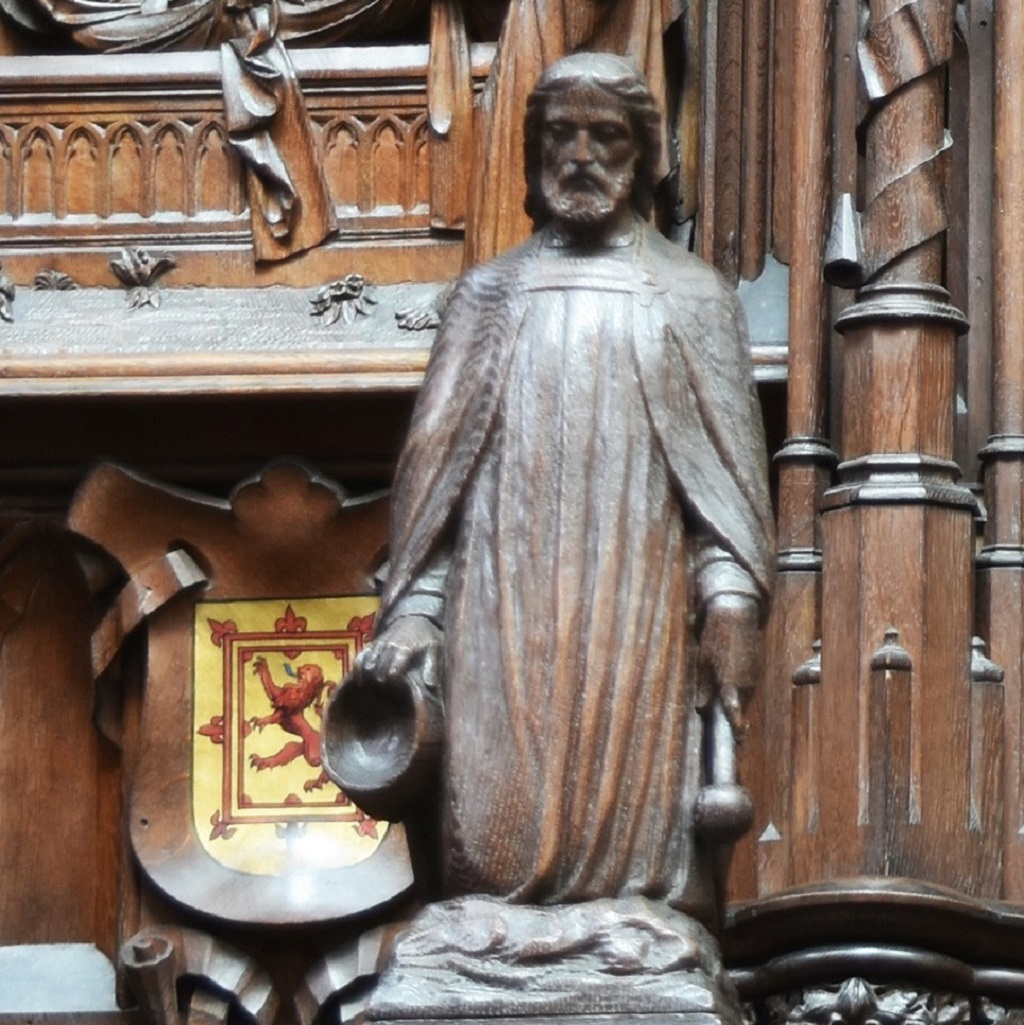
At the entrance to each side of the choir stalls angels making music accompany the singing in the choir. In the opposite zone of the southern stalls are the Beatitudes from Jesus’s Sermon on the Mount (Mth. 5:3-12), with which He praises a few attitudes to life of unconditional goodness as onsets of priceless happiness reaching to heaven. These ‘eight Beatitudes’ are to be read from left to right. Because in the Catholic Church until the Second Vatican CouncilA large meeting of ecclesiastical office holders, mainly bishops, presided by the pope, to make decisions concerning faith, church customs, etc. A council is usually named after the place where it was held. Examples: the Council of Trent [1645-1653] and the Second Vatican Council [1962-1965], which is also the last council for the time being. the Vulgate was used as the standard Bible text, the order of the second and third beatitude differ from the present Bible translation:
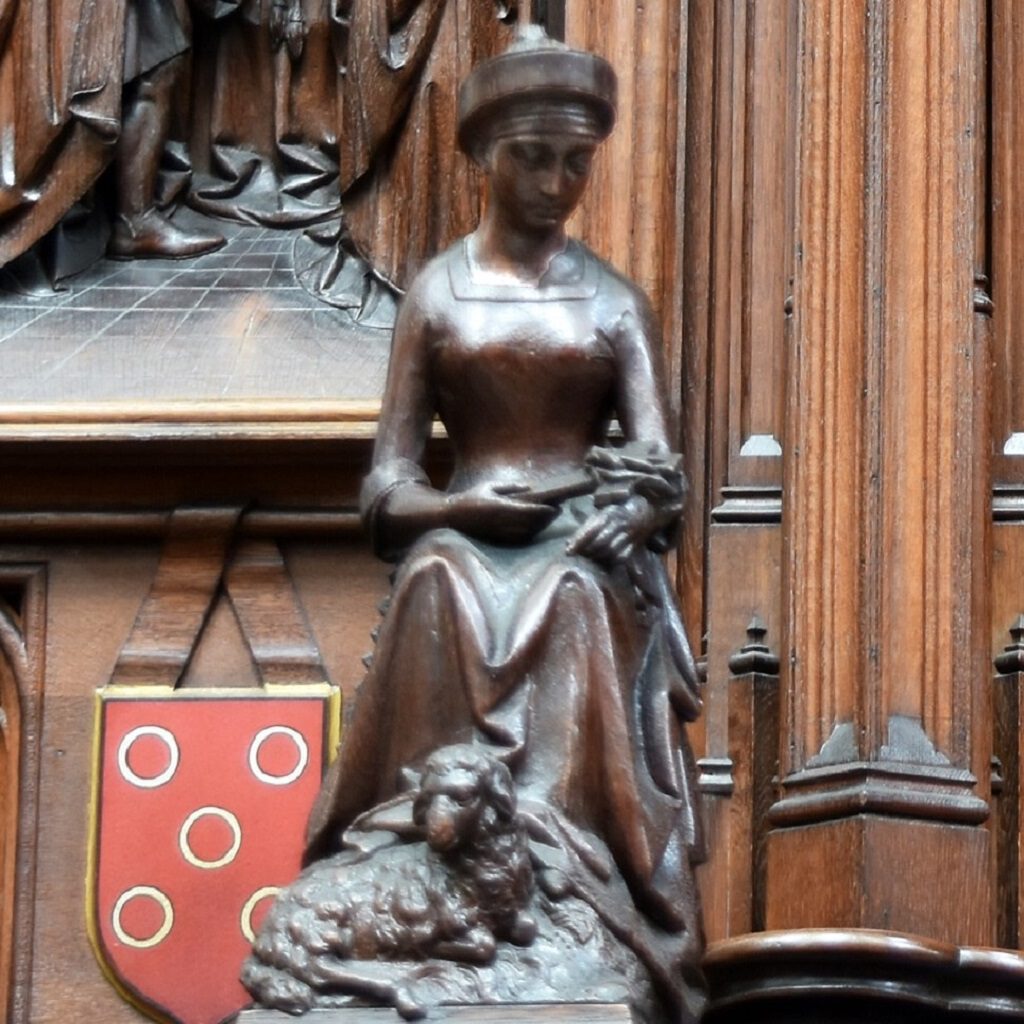
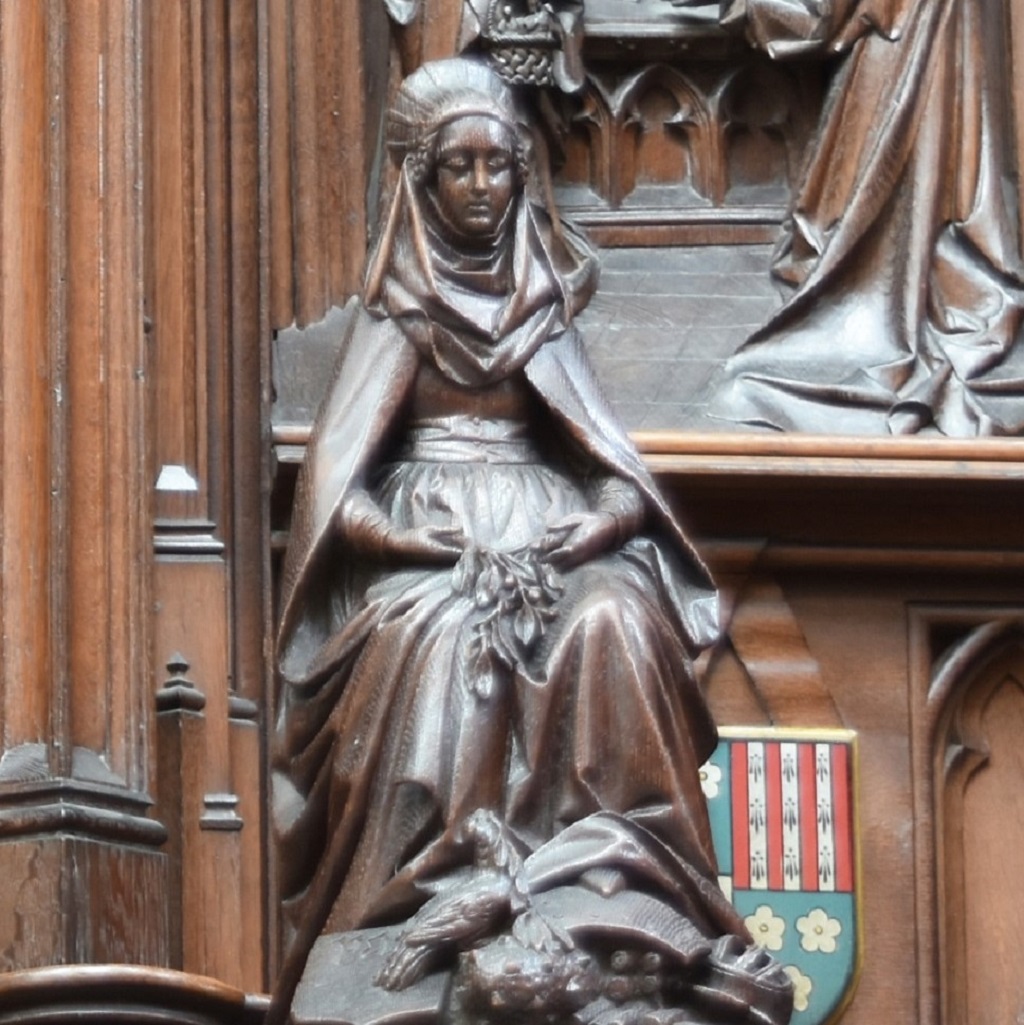
However much the rich imagery wants to be uplifting, the playfulness, which is so typical of many medieval choir stalls, is also present here, but not at eye-level. Nevertheless the funny figures in the canopies – of which there are more than one might think at first sight – are essential parts of choir stalls. God deserves to be praised by the entire creation: with their merry songs and music the numerous busts of angels, adults and choir boys support the liturgical lauds underneath them in the choir stalls. In its way also flora sings the praises of creation. The (three) swallow’s nests evoke Psalm 84:1-3: How lovely are Your dwelling places, O Lord of hosts! My soul longed and even yearned for the courts of the Lord… The bird also has found a house, And the swallow a nest for herself, where she may lay her young, Even Your altars, O Lord of hosts, My King and my God. There are as many bats. Traditionally they symbolize dark powers, but for the time being they remain a big question mark.
Annexes mainly for the canons
The original chapter house (second half 14th century or beginning 15th century) was situated at the north side (see Saint Joseph’s chapel
A small church that is not a parish church. It may be part of a larger entity such as a hospital, school, or an alms-house, or it may stand alone.
An enclosed part of a church with its own altar.
). In 1482-1487 a number of service buildings were constructed under the lead of Herman de Waghemakere next to the southern ambulatoryProcessional way around the chancel, to which choir chapels and radiating chapels, if any, give way.. They included the chapter sacristyThe room where the priest(s), the prayer leader(s) and the altar server(s) and/or acolyte(s) prepare and change clothes for Mass., now the large sacristy, which is as close to the sanctuary as possible. The adjacent chapter library was adapted as chapter house after 1585, while the library was moved to the more sunny ‘Papenhof’.
For the numerous chaplains who were in charge of one of the tens of side altars, a special sacristy was built. Besides there was even a separate ‘bread and wine counter’, where the sacramental wine and the wafers were kept.
The churchwardens, who worked together with the chapter until the French Revolutionary Rule, were given a meeting room of their own with the adjacent ‘pay room’ (actually a strongroom), which was situated inside the former exterior wall of the ‘New Work’.

